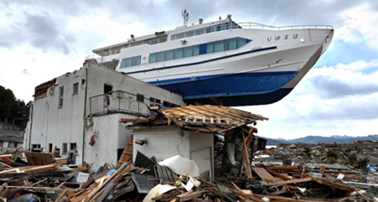MSN Japan sees new responsibilities grow from coverage
By Reed Price, Director, Network Programming, MSN US
Sean Chu, the Executive Producer of MSN Japan, says the experience of responding editorially to the Magnitude 9 Earthquake that hit Japan on March 11, 2011, gave his team a sense of how they could be a powerful force to help people cope not only with the quake, tsunami, and nuclear disaster -- but with the societal aftershocks that will lingeras well.
In an interview Saturday, March 26, Chu said, “over the past few weeks, my team has worked very, very hard. Literally, we were on this 24/7. We got together for dinner [Friday] night -- the first time after the quake -- and I was glad to hear that they actually want to do even more. We're all very tired and fatigued but they didn't want to stop.”
The team was hard at work on the 22nd-floor of an office building in Tokyo’s Shinagawa Citywhen the quake struck. At first, Chu said, the seriousness of the situation didn’t dawn on them. “We thought that this was a big earthquake and it's gone and -- though we were all shaken and scared we just went back to our desks and started working,” he said. “But around probably 3:30-4:00 we started getting news from the Tohoku region and at that time we knew that the elevator had stopped and a lot of the trains had also stopped. That was about the time that we started to understand the severity of the quake itself.”
Many team members spent the first night together at the office building, supplied with emergency kits of blankets and water from Microsoft, and venturing up and down the 22 flights of stairs for other provisions from nearby grocery stores. By Sunday, Chu said, it was clear that they needed to reassess how they were going to respond to the crisis. The team came up with “a laundry list of all the possible information and tools that people may need,” Chu said, and agreed to create a special portal to house the information. The focus: “helping people to manage their lives, helping people to navigate their lives through the situation.”
The team restructured itself on the fly and reached out to power companies, to the government, and other sources for life planninginformation. One team member worked closely to see how Microsoft as a whole was helping, and included that information in their special portal page. It was a small group—just 19 full-time employees—and they told the larger Microsoft Japan about their work. Chu said he was touched by the outreach from the 2,500 employees across divisions: “We've had the Azure team help us, we've had the Hotmail team help us, the Silverlight team help us, we've had EPG (the Enterprise and Partner Group) help us. The entire company is trying to help us program this,” Chu marvels.
Screen shot from MSNBC’s Photo Blog: Panoramic image: Sightseeing ship atop house in Otsuchi, Japan
In the last week, the MSN Japan team made a conscious effort to shift the emphasis of their programming toward Recovery and Revitalization. They adopted a new “Support Japan” logo and, with help from the US Engineering deployed a new user-generated site where they are inviting the audience to upload pictures and videos. “People can share their messages and thoughts: “I'm turning out my lights,” “I'm gathering blankets to send over”, or “I'm actually going out and having a big dinner with my friends and helping the economy,” Chu said. “Anything like that is fine. I think we were one of the first portals to do that, to try to gather that information.”
Chu said, “I know as editors we try to look at all the news and it really is depressing, it really drags you down. And somewhere down the line I felt responsible, that I needed to show our audience that this was devastating, yes … but we need to move on. We need to stay a little bit more optimistic and upbeat about it so that we can move on with our lives and help the economy get back on its feet. So I wanted to do as much as we can, as MSN, to do that.”
